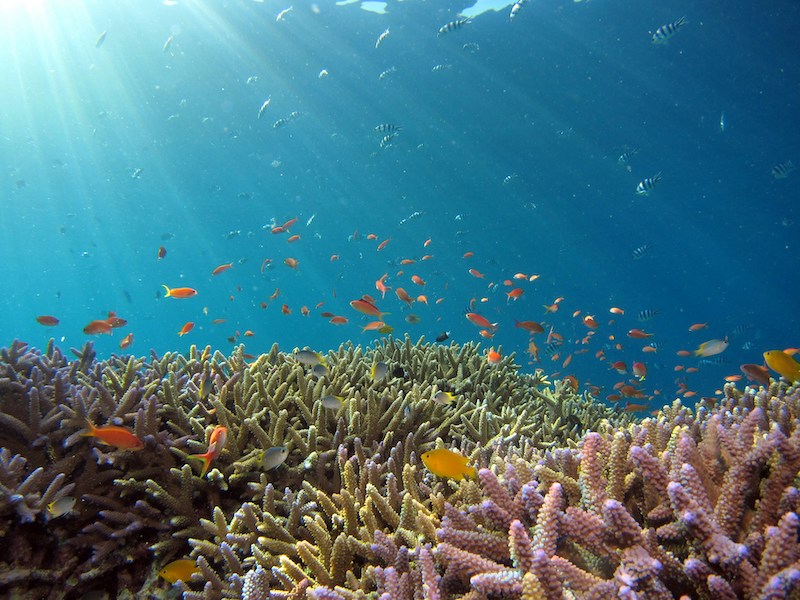Our Terms & Conditions | Our Privacy Policy
Scientists Develop a Gel Boosting Coral Reef Settlement By 20x

Photo: Hiroko Yoshii via Unsplash
According to scientists at UC San Diego, coral larvae can be picky about where they attach and settle down. But some things have the power to determine the larvae’s journey: certain chemicals associated with healthy reefs. Larvae will “smell” their way to these chemicals, and, upon finding them, decide to latch onto the associated area. In an effort to combat reef erosion, that very same team of UC scientists has developed a new gel using nano-particles that slowly releases some of coral larvae’s favorite “smells.”
When the gel, called SNAP-X, was applied to surfaces in lab experiments, the researchers found that it increased coral larvae settlement by up to 20 times compared to untreated surfaces. Recently published in Trends in Biotechnology, these results seem to suggest that SNAP-X could serve as an unprecedented solution to restoring coral habitats. Notably, the gel also functions as a coating and can release coral-attracting chemicals for up to a month, a clear testament to its durability.
“Coral are animals, and their larvae are selective about where they are going to attach because once they do, they’re stuck there,” Daniel Wangpraseurt, the study’s senior author, said in a statement. “With SNAP-X, we created a material that releases chemical cues that tell larvae this is a good place to live.”
Despite covering less than 1% of the ocean floor, coral reefs house approximately a quarter of all known marine species, providing food, shelter, and an altogether complex ecosystem. These “rainforests of the sea,” however, are severely impacted by climate change, with the Global Coral Reef Monitoring Network discovering that, since 2009, 14% of corals have already disappeared. In 2018, a special report from the Intergovernmental Panel on Climate Change projected that coral reefs would decline by 70% to 90% if average global air temperatures warmed by 2.7°F above pre-industrial levels. At 3.6°F, the corals would decline by a staggering 99%.
This study arrives at a time of intense uncertainty for coral reefs, and offers a possible glimmer of hope. In the past, a major hurdle scientists had to overcome was the pickiness of coral larvae, which wouldn’t readily settle on degraded reefs or attach to human-created structures. Nursery-grown corals posed other problems due to being “genetically identical.”
“If there’s a warming event or a disease outbreak, it can wipe out the whole population,” Wangpraseurt says. “Ideally, we want to recruit corals naturally, which can introduce genetic diversity to the population and enhance their resilience.”
Wangpraseurt and his lab at UC San Diego were hoping to address these challenges with SNAP-X, a substance that delivered the necessary chemical cues to the larvae over an extended period of time.
“If you just throw these chemical cues in the ocean they dissipate very quickly, making it hard for coral larvae to find their source,” Samapti Kundu, a postdoctoral researcher who worked on the project with Wangpraseurt, added. “We needed to develop something like an extended release drug delivery system that would slowly release these settlement cues in the ocean.”
But how, exactly, does one design such a system? The team’s answer is by “encapsulating chemical compounds extracted from crustose coralline algae in nanoparticles made of silica.” Afterward, these nanoparticles are suspended in a liquid gel that would solidify “like Jell-O” when exposed to UV light. Because of this, the team could paint or spray this substance onto a surface and later cure it with UV light for the sake of durability.
“What we sometimes forget is that coral reefs are one of the best structures in protecting our coasts,” Wangpraseurt concludes. “I think this material is a breakthrough that can hopefully make a big contribution to coral restoration.”
To learn more, read the team’s full study in Trends in Biotechnology.
A team of scientists from UC San Diego have developed SNAP-X, a gel that promotes the settlement and growth of coral larvae.


Photo: Shaun Low via Unsplash
SNAP-X slowly releases special chemicals associated with healthy reefs, attracting these larvae for up to a month.


Photo: QUI NGUYEN via Unsplash
SNAP-X could serve as an unprecedented solution to restoring these habitats, which serve as one of the world’s most important marine ecosystems.


A variety of corals form an outcrop on Flynn Reef, part of the Great Barrier Reef near Cairns, Queensland, Australia. (Photo: Toby Hudson via Wikimedia Commons, CC 3.0)
Sources: Biomimetic chemical microhabitats enhance coral settlement; New Gel Could Boost Coral Reef Restoration; An ink that boosts coral reef settlement by 20 times; Vanishing Corals: NASA Data Helps Track Coral Reefs
Related Articles:
3D-Printed Coral Reefs Are Restoring Mexican Caribbean Ecosystems
New Research Shows Artificially Restored Coral Reefs Can Grow as Fast as Healthy Reefs
Scientists Create 3D-Printed Terra Cotta Tiles to Encourage Coral Reef Growth
Images are for reference only.Images and contents gathered automatic from google or 3rd party sources.All rights on the images and contents are with their legal original owners.



Comments are closed.